 President Barack Obama signed an executive order on January 22, 2009, to close the detention facilities at Guantanamo Bay, Cuba, within a year. Nearly six years later, the prison for terrorism suspects remains open. Click through for a look inside the controversial facility. Here, President George W. Bush's official picture is replaced by Obama's in the lobby of the headquarters of the U.S. naval base at Guantanamo on January 20, 2009, the day the latter was sworn in as president.
President Barack Obama signed an executive order on January 22, 2009, to close the detention facilities at Guantanamo Bay, Cuba, within a year. Nearly six years later, the prison for terrorism suspects remains open. Click through for a look inside the controversial facility. Here, President George W. Bush's official picture is replaced by Obama's in the lobby of the headquarters of the U.S. naval base at Guantanamo on January 20, 2009, the day the latter was sworn in as president. 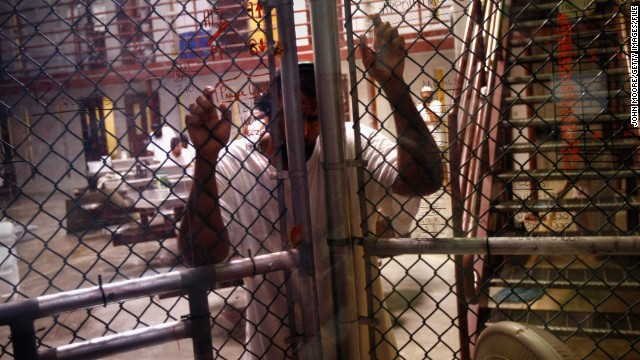 The U.S. naval base at Guantanamo Bay has held terror suspects since January 2002. Early in the war on terror, the Bush administration argued these detainees were "enemy combatants" who didn't have the protections accorded to prisoners of war under the Geneva Conventions. Here, a detainee stands at an interior fence at Guantanamo Bay in October 2009.
The U.S. naval base at Guantanamo Bay has held terror suspects since January 2002. Early in the war on terror, the Bush administration argued these detainees were "enemy combatants" who didn't have the protections accorded to prisoners of war under the Geneva Conventions. Here, a detainee stands at an interior fence at Guantanamo Bay in October 2009. 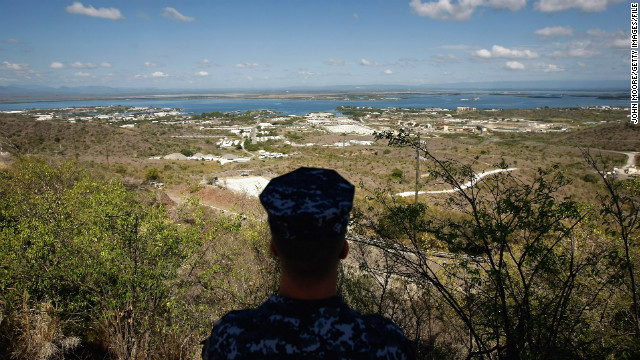 A Navy sailor surveys the U.S. naval base at Guantanamo Bay in October 2009. In December 2013, Congress passed a defense spending bill that makes it easier to transfer detainees out of the facility.
A Navy sailor surveys the U.S. naval base at Guantanamo Bay in October 2009. In December 2013, Congress passed a defense spending bill that makes it easier to transfer detainees out of the facility. 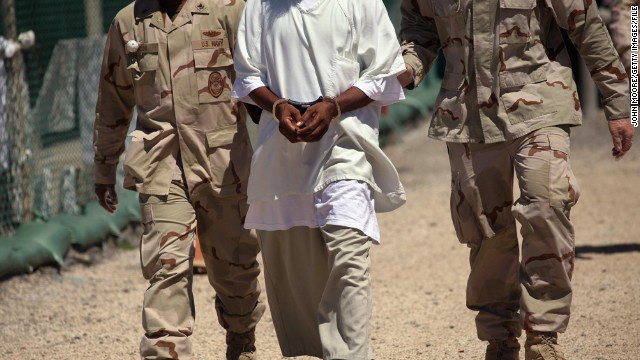 U.S. military guards move a detainee inside the detention center in September 2010. At its peak, the detainee population exceeded 750 men at Guantanamo.
U.S. military guards move a detainee inside the detention center in September 2010. At its peak, the detainee population exceeded 750 men at Guantanamo. 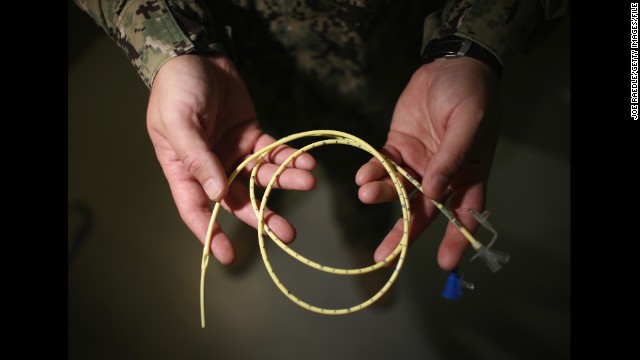 A military doctor holds a feeding tube used to feed detainees on a hunger strike at a Camp Delta hospital at Guantanamo in June 2013. In March 2013, the U.S. military announced that dozens of detainees had begun a hunger strike. By that June, more than 100 detainees were on a hunger strike, and more than 40 were being force-fed, military officials said.
A military doctor holds a feeding tube used to feed detainees on a hunger strike at a Camp Delta hospital at Guantanamo in June 2013. In March 2013, the U.S. military announced that dozens of detainees had begun a hunger strike. By that June, more than 100 detainees were on a hunger strike, and more than 40 were being force-fed, military officials said. 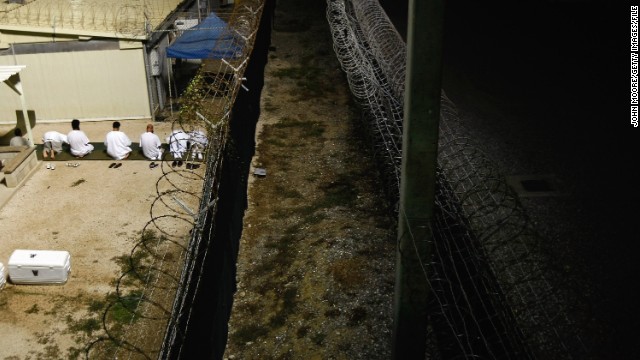 Muslim detainees kneel during early morning prayers in October 2009. Cells are marked with an arrow pointing in the direction of Mecca, regarded as Islam's holy city.
Muslim detainees kneel during early morning prayers in October 2009. Cells are marked with an arrow pointing in the direction of Mecca, regarded as Islam's holy city.  A soldier stands near a placard on the fence line of the detention facility in January 2012.
A soldier stands near a placard on the fence line of the detention facility in January 2012.  A Quran sits among a display of items isssued to detainees in September 2010. The suspects are given a prayer mat and a copy of the Muslim holy book as well as a toothbrush, soap, shampoo and clothing.
A Quran sits among a display of items isssued to detainees in September 2010. The suspects are given a prayer mat and a copy of the Muslim holy book as well as a toothbrush, soap, shampoo and clothing. 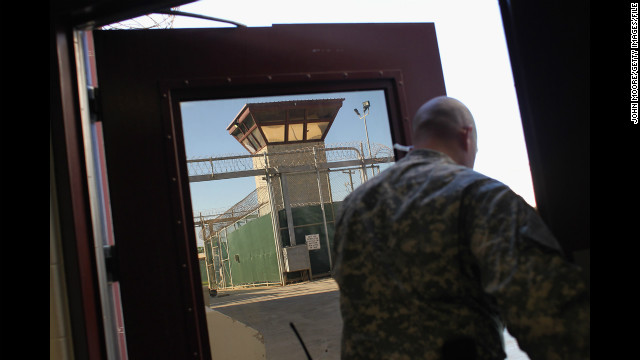 A U.S. military guard walks out of the maximum security section of the detention center in September 2010.
A U.S. military guard walks out of the maximum security section of the detention center in September 2010.  A German shepherd police dog undergoes training exercises in October 2009 at Guantanamo Bay.
A German shepherd police dog undergoes training exercises in October 2009 at Guantanamo Bay. 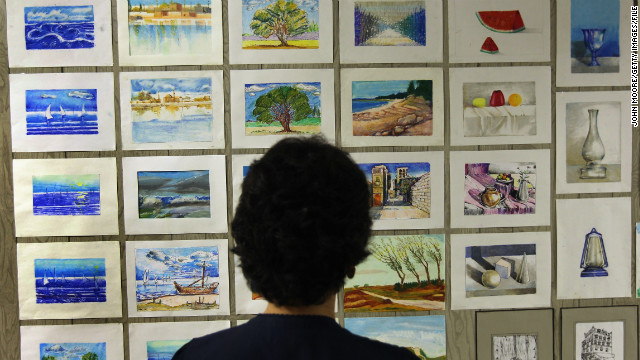 A camp librarian views artwork painted by detainees in September 2010.
A camp librarian views artwork painted by detainees in September 2010.  A detainee rubs his face while attending a "life skills" class inside the Camp 6 high-security detention facility in April 2009.
A detainee rubs his face while attending a "life skills" class inside the Camp 6 high-security detention facility in April 2009. 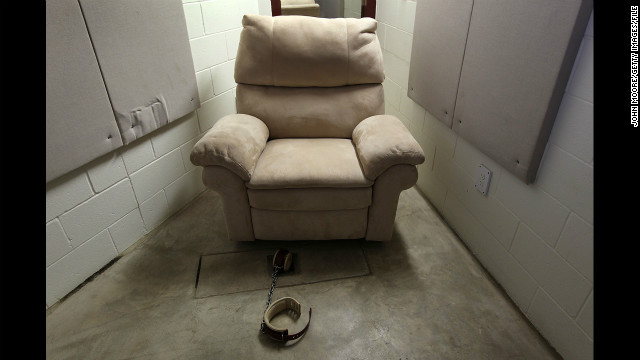 A seat and shackle await a detainee in the DVD room of the maximum security Camp 5 detention center in March 2010.
A seat and shackle await a detainee in the DVD room of the maximum security Camp 5 detention center in March 2010.  U.S. Marines join in martial arts training at the U.S. naval base in September 2010.
U.S. Marines join in martial arts training at the U.S. naval base in September 2010. 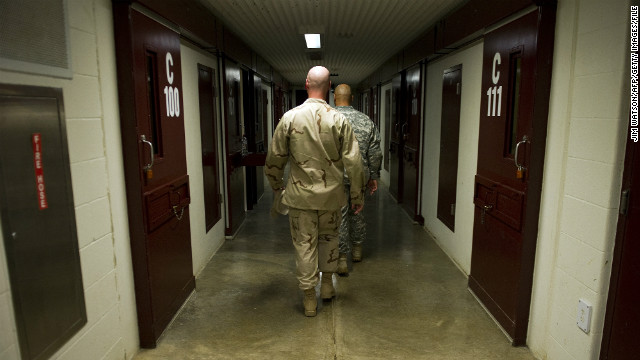 Members of the military walk the hallway of Cell Block C in the Camp 5 detention facility in January 2012.
Members of the military walk the hallway of Cell Block C in the Camp 5 detention facility in January 2012. 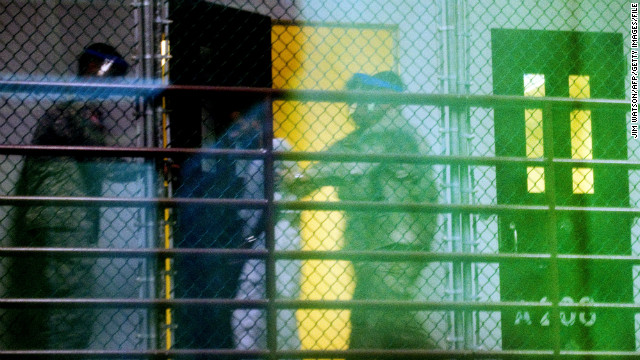 Guards move a detainee from his cell in Cell Block A of the Camp 6 detention facility in January 2012.
Guards move a detainee from his cell in Cell Block A of the Camp 6 detention facility in January 2012. 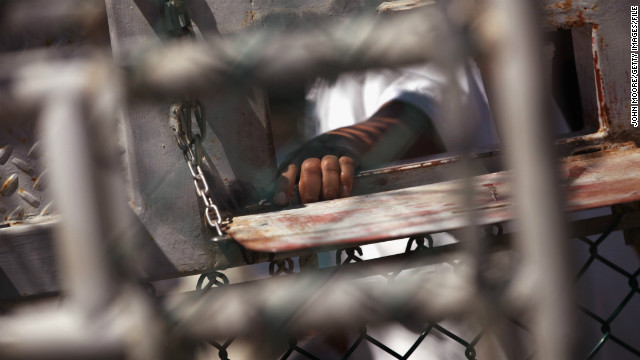 A detainee waits for lunch in September 2010. The cost of building Guantanamo's high-security detention facilities was reportedly about $54 million.
A detainee waits for lunch in September 2010. The cost of building Guantanamo's high-security detention facilities was reportedly about $54 million.  Marines get an early-morning workout at the U.S. naval base at Guantanamo Bay in October 2009.
Marines get an early-morning workout at the U.S. naval base at Guantanamo Bay in October 2009.  A bus carries military guards from their night shift at the detention center in September 2010.
A bus carries military guards from their night shift at the detention center in September 2010.  A military guard puts on gloves before moving a detainee within the detention center in September 2010.
A military guard puts on gloves before moving a detainee within the detention center in September 2010. 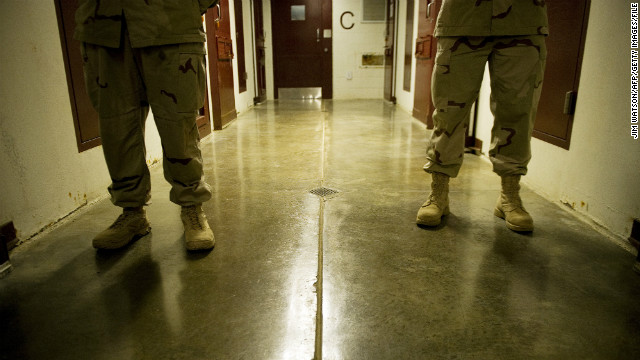 Members of the U.S. Navy move down the hallway of Cell Block C in the Camp 5 detention facility in January 2012.
Members of the U.S. Navy move down the hallway of Cell Block C in the Camp 5 detention facility in January 2012. 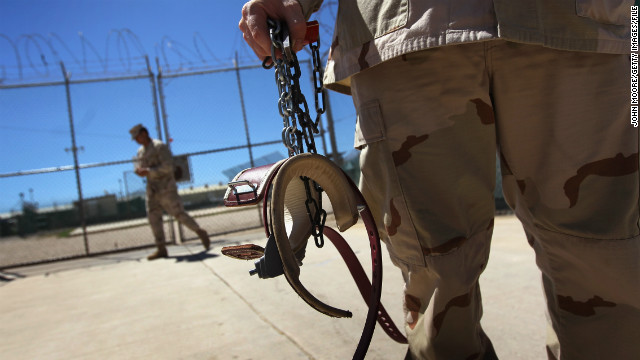 A U.S. military guard holds shackles before preparing to move a detainee in September 2010.
A U.S. military guard holds shackles before preparing to move a detainee in September 2010. 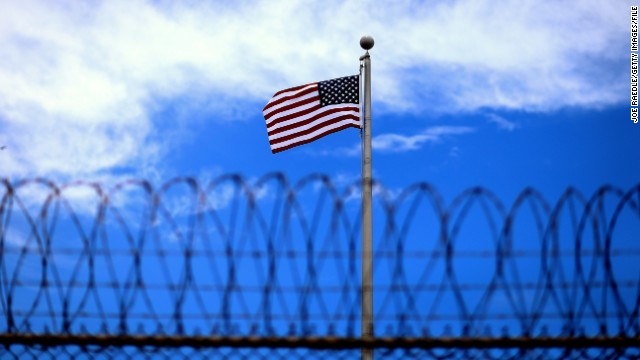 An American flag flies over Camp 6 at Guantanamo in June 2013.
An American flag flies over Camp 6 at Guantanamo in June 2013.
- Two Yemenis and three Tunisians transferred
- Guantanamo Bay has held nearly 800 detainees
(CNN) -- The U.S. government has transferred five more Guantanamo Bay detainees, shrinking the number to 127.
The detainees, two Yemeni and three Tunisians, were repatriated to Kazakhstan, after the Guantanamo Review Task Force said it determined the men did not pose security threats.
The Defense Department identified the men as Asim Thabit Abdullah Al-Khalaqi, Muhammad Ali Husayn Khanayna, Sabri Muhammad Ibrahim Al Qurashi, Adel Al-Hakeemy, and Abdullah Bin Ali Al-Lufti.
 Graham on North Korea and Guantanamo Bay
Graham on North Korea and Guantanamo Bay The move advances President Barack Obama's goal of drawing down the number of those held at the U.S. naval base in southeastern Cuba, something that has been ongoing for years.
The departures of the five men means that 127 people are still detained at Guantanamo.
 McCain offers hope that Gitmo could be closed
McCain offers hope that Gitmo could be closed This is down significantly from the numbers soon after the September 11, 2001, terrorist attacks, when the facility widely known as Gitmo was repurposed to hold detainees from the "war on terror."
The administration of then-President George W. Bush claimed that, since Gitmo detainees weren't held on American soil, they could be considered "enemy combatants" and be denied some legal protections. Almost all of the nearly 800 detainees were held without charges.
This legal limbo, as well as allegations of torture and other mistreatment, spurred criticism of Gitmo. Shortly after his 2009 inauguration, President Barack Obama signed an executive order to close the detention facility within a year.
That didn't happen.
One reason was because of strong opposition from lawmakers, many of them Republicans, who cited the risk of freeing men who had fought to kill Americans.
About 17% of the 620 Gitmo detainees released -- most of them during Bush's presidency -- went on to engage in terrorist activities, a September semiannual report from the director of national intelligence found. Another 12% are suspected of having engaged in terrorist or insurgent activities.
CNN's Greg Botelho, Jonathan Berryman, Masoud Popalzai and Jamie Crawford contributed to this report.
Source: Top Stories - Google News - http://news.google.com/news/url?sa=t&fd=R&ct2=us&usg=AFQjCNGw8jzrVqb-A9CUGaSIrpSguTim2Q&clid=c3a7d30bb8a4878e06b80cf16b898331&cid=52778698312651&ei=GJejVOXQLsqqgAeu8IGAAQ&url=http://www.cnn.com/2014/12/31/us/guantanamo-detainees-transferred/
 Graham on North Korea and Guantanamo Bay
Graham on North Korea and Guantanamo Bay  McCain offers hope that Gitmo could be closed
McCain offers hope that Gitmo could be closed 
 President Barack Obama signed an executive order on January 22, 2009, to close the detention facilities at Guantanamo Bay, Cuba, within a year. Nearly six years later, the prison for terrorism suspects remains open. Click through for a look inside the
President Barack Obama signed an executive order on January 22, 2009, to close the detention facilities at Guantanamo Bay, Cuba, within a year. Nearly six years later, the prison for terrorism suspects remains open. Click through for a look inside the  The U.S. naval base at Guantanamo Bay has held
The U.S. naval base at Guantanamo Bay has held  A Navy sailor surveys the U.S. naval base at Guantanamo Bay in October 2009. In December 2013, Congress
A Navy sailor surveys the U.S. naval base at Guantanamo Bay in October 2009. In December 2013, Congress  U.S. military guards move a detainee inside the detention center in September 2010. At its peak, the detainee population exceeded 750 men at Guantanamo.
U.S. military guards move a detainee inside the detention center in September 2010. At its peak, the detainee population exceeded 750 men at Guantanamo.  A military doctor holds a feeding tube used to feed detainees on a hunger strike at a Camp Delta hospital at Guantanamo in June 2013. In March 2013, the U.S. military announced that dozens of detainees had begun a hunger strike. By that June,
A military doctor holds a feeding tube used to feed detainees on a hunger strike at a Camp Delta hospital at Guantanamo in June 2013. In March 2013, the U.S. military announced that dozens of detainees had begun a hunger strike. By that June,  Muslim detainees kneel during early morning prayers in October 2009. Cells are marked with an arrow pointing in the direction of Mecca, regarded as Islam's holy city.
Muslim detainees kneel during early morning prayers in October 2009. Cells are marked with an arrow pointing in the direction of Mecca, regarded as Islam's holy city.  A soldier stands near a placard on the fence line of the detention facility in January 2012.
A soldier stands near a placard on the fence line of the detention facility in January 2012.  A Quran sits among a display of items isssued to detainees in September 2010. The suspects are given a prayer mat and a copy of the Muslim holy book as well as a toothbrush, soap, shampoo and clothing.
A Quran sits among a display of items isssued to detainees in September 2010. The suspects are given a prayer mat and a copy of the Muslim holy book as well as a toothbrush, soap, shampoo and clothing.  A U.S. military guard walks out of the maximum security section of the detention center in September 2010.
A U.S. military guard walks out of the maximum security section of the detention center in September 2010.  A German shepherd police dog undergoes training exercises in October 2009 at Guantanamo Bay.
A German shepherd police dog undergoes training exercises in October 2009 at Guantanamo Bay.  A camp librarian views artwork painted by detainees in September 2010.
A camp librarian views artwork painted by detainees in September 2010.  A detainee rubs his face while attending a "life skills" class inside the Camp 6 high-security detention facility in April 2009.
A detainee rubs his face while attending a "life skills" class inside the Camp 6 high-security detention facility in April 2009.  A seat and shackle await a detainee in the DVD room of the maximum security Camp 5 detention center in March 2010.
A seat and shackle await a detainee in the DVD room of the maximum security Camp 5 detention center in March 2010.  U.S. Marines join in martial arts training at the U.S. naval base in September 2010.
U.S. Marines join in martial arts training at the U.S. naval base in September 2010.  Members of the military walk the hallway of Cell Block C in the Camp 5 detention facility in January 2012.
Members of the military walk the hallway of Cell Block C in the Camp 5 detention facility in January 2012.  Guards move a detainee from his cell in Cell Block A of the Camp 6 detention facility in January 2012.
Guards move a detainee from his cell in Cell Block A of the Camp 6 detention facility in January 2012.  A detainee waits for lunch in September 2010. The cost of building Guantanamo's high-security detention facilities was reportedly about $54 million.
A detainee waits for lunch in September 2010. The cost of building Guantanamo's high-security detention facilities was reportedly about $54 million.  Marines get an early-morning workout at the U.S. naval base at Guantanamo Bay in October 2009.
Marines get an early-morning workout at the U.S. naval base at Guantanamo Bay in October 2009.  A bus carries military guards from their night shift at the detention center in September 2010.
A bus carries military guards from their night shift at the detention center in September 2010.  A military guard puts on gloves before moving a detainee within the detention center in September 2010.
A military guard puts on gloves before moving a detainee within the detention center in September 2010.  Members of the U.S. Navy move down the hallway of Cell Block C in the Camp 5 detention facility in January 2012.
Members of the U.S. Navy move down the hallway of Cell Block C in the Camp 5 detention facility in January 2012.  A U.S. military guard holds shackles before preparing to move a detainee in September 2010.
A U.S. military guard holds shackles before preparing to move a detainee in September 2010.  An American flag flies over Camp 6 at Guantanamo in June 2013.
An American flag flies over Camp 6 at Guantanamo in June 2013. 






















0 comments:
Post a Comment